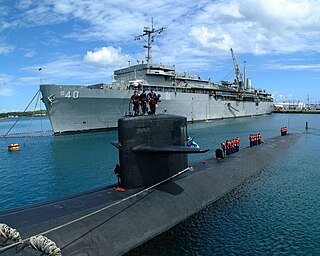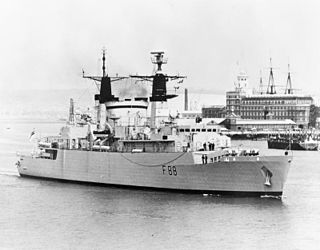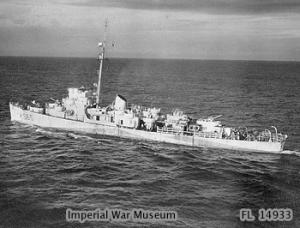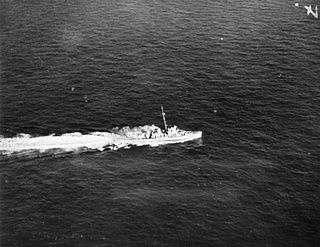
HMS Ark Royal was a light aircraft carrier and former flagship of the Royal Navy. She was the third and final vessel of Invincible class. She was built by Swan Hunter on the River Tyne and launched by them in 1981. Ark Royal was christened by Queen Elizabeth The Queen Mother. She followed sister ships HMS Invincible and HMS Illustrious into service in 1985.

A submarine tender is a type of depot ship that supplies and supports submarines.

HMS Broadsword was the lead ship and first Batch 1 unit of the Type 22 frigates of the Royal Navy.

Landing platform helicopter (LPH) is a term used by some navies to denote a type of amphibious warfare ship designed primarily to operate as a launch and recovery platform for helicopters and other VTOL aircraft. As such, they are considered a type of helicopter carrier.

The first USS Hopewell (DD–181) was a Wickes-class destroyer in the United States Navy, entering service in 1919. After a brief active life, the ship was deactivated in 1922 and placed in reserve for 18 years before returning to service in 1940 during World War II. She was later transferred to the Royal Navy as HMS Bath (I17), as a Town-class destroyer, and then to the Royal Norwegian Navy as HNoMS Bath. Bath was torpedoed while escorting a trans-Atlantic convoy on 19 August 1941.

The Sandown class is a class of fifteen minehunters built primarily for the Royal Navy by Vosper Thornycroft. The Sandown class also serve with the Royal Saudi Navy and the Estonian Navy. The first vessel was commissioned into Royal Navy service on 9 June 1989 and all the British ships are named after coastal towns and cities. They have a secondary role as offshore patrol vessels.

HMS Caroline is a decommissioned C-class light cruiser of the Royal Navy that saw combat service in the First World War and served as an administrative centre in the Second World War. Caroline was launched and commissioned in 1914. At the time of her decommissioning in 2011 she was the second-oldest ship in Royal Navy service, after HMS Victory. She served as a static headquarters and training ship for the Royal Naval Reserve, based in Alexandra Dock, Belfast, Northern Ireland, for the later stages of her career. She was converted into a museum ship. From October 2016 she underwent inspection and repairs to her hull at Harland and Wolff and opened to the public on 1 July 2017 at Alexandra Dock in the Titanic Quarter in Belfast.

The Belgian Navy, officially the Belgian Naval Component of the Belgian Armed Forces, is the naval service of Belgium.

The Condell class was the name given to a class of two new build and upgraded type Leander-class frigates of the Chilean Navy, Almirante Condell and Almirante Lynch. They were ordered by the Chilean government in 1969 as ASW frigates. The ships were built between 1969 and 1973, under Chilean modifications, by Yarrow (Shipbuilders) Ltd. in Scotstoun, Glasgow. Almirante Condell arrived in Chile in 1973, with Almirante Lynch following in 1974.

Aircraft carriers have their origins during the days of World War I. The earliest experiments consisted of fitting temporary "flying off" platforms to the gun turrets of the warships of several nations, notably the United States and the United Kingdom. The first ship to be modified with a permanent flight deck was the battlecruiser HMS Furious, which initially had a single flying-off deck forward of the original superstructure. Subsequently, she was modified with a separate "landing on" deck aft and later with a full flush deck. Other ships, often liners, were modified to have full flush flight decks, HMS Argus being the first to have such modification begun. Those first faltering steps gave little indication of just how important the aircraft carrier was to prove to be. During the inter-war years, Japan, the United Kingdom and the United States built up significant carrier fleets so that by the beginning of World War II, they had 18 carriers between them. The 1940 Battle of Taranto and 1941 Attack on Pearl Harbor in retrospect showed the world that the aircraft carrier was to be the most important ship in the modern fleet. Today, aircraft carriers are the capital ships of the navies they serve in, and in the case of modern US "supercarriers", they embark an air group that is effectively a small air force.

The Battlecruiser Squadron was a Royal Navy squadron of battlecruisers that saw service from 1919 to the early part of the Second World War. Its best-known constituent ship was HMS Hood, "The Mighty Hood", which was lost in the Battle of the Denmark Strait on 24 May 1941. Following the loss of HMS Repulse on 10 December 1941, Battlecruiser Squadron was disbanded. Its last surviving member, HMS Renown, survived World War II and was removed from service and scrapped in 1948.

HMAS Doomba was a Royal Australian Navy (RAN) warship of World War II. Built for the Royal Navy around the end of World War I as the Hunt-class minesweeper HMS Wexford, the ship only saw two years of service before she was decommissioned in 1921 and sold to the Doomba Shipping Company. The vessel was renamed SS Doomba, converted into a passenger ship, and operated in the waters around Brisbane until 1939, when she was requisitioned by the RAN for wartime service. Serving first as an auxiliary minehunter, then an auxiliary anti-submarine vessel, HMAS Doomba was purchased outright by the RAN in 1940, and served until early 1946, when she was sold and converted into a linseed oil lighter. Doomba was scuttled off Dee Why, New South Wales in 1976.

HMS Thornborough (K574), sometimes spelled Thornbrough, was a British Captain-class frigate of the Royal Navy in commission during World War II. Originally constructed as a United States Navy Buckley class destroyer escort, the ship served in the Royal Navy from 1943 to 1945.
HMS Gardiner (K478) was a British Captain-class frigate of the Royal Navy in commission during World War II. Originally constructed as the United States Navy Evarts-class destroyer escort USS O'Toole (DE-274), she served in the Royal Navy from 1943 to 1946.

HMS Inman (K471) was a Captain-class frigate of the Royal Navy in commission in World War II. Originally built as the United States Navy Evarts-class destroyer escort DE-526, she served in the Royal Navy from 1944 to 1945.

HMS Loring (K565) was a British Captain-class frigate of the Royal Navy in commission during World War II. Originally constructed as the United States Navy Evarts-class destroyer escort DE-520, she served in the Royal Navy from 1943 to 1945.

The second HMS Moorsom (K567) was a British Captain-class frigate of the Royal Navy in commission during World War II. Originally constructed as the United States Navy Evarts-class destroyer escort DE-522, she served in the Royal Navy from 1943 to 1945.















